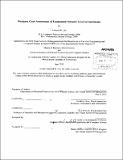| dc.contributor.advisor | Jonathan How and Roy Welsch. | en_US |
| dc.contributor.author | Liu, Edward W | en_US |
| dc.contributor.other | Leaders for Global Operations Program. | en_US |
| dc.date.accessioned | 2012-09-27T15:29:51Z | |
| dc.date.available | 2012-09-27T15:29:51Z | |
| dc.date.copyright | 2012 | en_US |
| dc.date.issued | 2012 | en_US |
| dc.identifier.uri | http://hdl.handle.net/1721.1/73405 | |
| dc.description | Thesis (M.B.A.)--Massachusetts Institute of Technology, Sloan School of Management; and, (S.M.)--Massachusetts Institute of Technology, Dept. of Electrical Engineering and Computer Science; in conjunction with the Leaders for Global Operations Program at MIT, 2012. | en_US |
| dc.description | Cataloged from PDF version of thesis. | en_US |
| dc.description | Includes bibliographical references (p. 71-73). | en_US |
| dc.description.abstract | The federal government has continually increased its spending on unmanned aerial vehicles (UAVs) during the past decade. Efforts to drive down UAV costs have primarily focused on the physical characteristics of the UAV, such as weight, size, and shape. Due to the saturation of the UAV business in the federal sector, the civilian sector is not as penetrated. Hence, companies see this phenomenon as an opportunity to establish itself as the standard bearer in this sector. This thesis will address how Boeing can establish guidelines for business strategies in UAV offerings to potential clients. The key innovation that will be introduced is a modeling tool that will focus on simulation/trending and sensitivity analysis to help provide some insight into what these guidelines will be. The modeling tool will quantify many of the benefits and costs of the components and features of the production and utilization of UAVs. Other notable recommendations include defining a new data recording process to obtain sets of sample data to validate the results of the modeling tool and streamlining the complexity of additional features and enhancements that will be incorporated in future versions of the modeling tool. | en_US |
| dc.description.statementofresponsibility | by Edward W. Liu. | en_US |
| dc.format.extent | 73 p. | en_US |
| dc.language.iso | eng | en_US |
| dc.publisher | Massachusetts Institute of Technology | en_US |
| dc.rights | M.I.T. theses are protected by
copyright. They may be viewed from this source for any purpose, but
reproduction or distribution in any format is prohibited without written
permission. See provided URL for inquiries about permission. | en_US |
| dc.rights.uri | http://dspace.mit.edu/handle/1721.1/7582 | en_US |
| dc.subject | Sloan School of Management. | en_US |
| dc.subject | Electrical Engineering and Computer Science. | en_US |
| dc.subject | Leaders for Global Operations Program. | en_US |
| dc.title | Business case assessment of unmanned systems level of autonomy | en_US |
| dc.type | Thesis | en_US |
| dc.description.degree | S.M. | en_US |
| dc.description.degree | M.B.A. | en_US |
| dc.contributor.department | Leaders for Global Operations Program at MIT | en_US |
| dc.contributor.department | Massachusetts Institute of Technology. Department of Electrical Engineering and Computer Science | |
| dc.contributor.department | Sloan School of Management | |
| dc.identifier.oclc | 810144613 | en_US |
